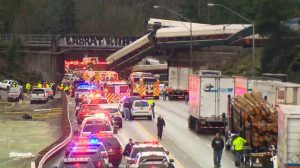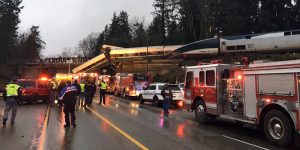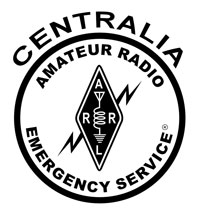
At 7:30am on Monday, December 18th, the Amtrak Cascade 501 passenger train travelling south along the I-5 corridor, experienced a horrific derailment just as it was passing over Interstate 5. Of the two locomotives and twelve passenger cars, all but the trailing locomotive left the tracks, some crashing onto Interstate-5 during the busy morning commute.
The train was carrying 80 passengers and five crew members at the time of the accident. 72 people were transported from the scene with injuries, 19 others were uninjured and three died at the scene. One passenger was flown out by life flight to a nearby hospital.
Below, on Interstate 5, five cars and 2 semi trucks were damaged and while there were injuries, no fatalities occurred on the freeway. Immediately, Interstate-5, both northbound and southbound, came to a standstill. While all northbound lanes were opened later in the day, all southbound lanes remain closed 48 hours later. No reopening date has been scheduled as transportation crews work to remove railroad cars, assesse damage and repair road surfaces.
Centralia ARES volunteers may well be the only ARES team in the region, if not the entire state, to have trained for deployment to this kind of catastrophe in support of our first responders. But what would this deployment have looked like and, more importantly, are you ready if the call comes today?
During an extensive eight month training program based on a similar but more deadly train derailment and explosion in Canada, we conducted exercises involving, evacuations, sheltering, communications, staging areas, first responder support and life flight operations which included setting up a landing zone and bringing in an actual Airlift Northwest helicopter. While many facts are still coming in concerning this particular disaster, we can draw some conclusions.
Almost immediately, I-5 itself, became a large staging area as support vehicles of all kinds simply used the southbound lanes as a parking lot. Photos show many response vehicles at the scene. It seems unlikely that other staging areas would be necessary. Train cars removed from the site were taken to JBLM military base where basic security could be established. Mass casualty triage was conducted on site and could have been one of the locations ARES volunteers might be used. Some sheltering may have been required until all uninjured passengers could be reunited with relatives and transportation home but would have been only short term, probably not requiring an overnight stay in a shelter.
Hopefully, standard amateur radio back up communications to the Emergency Operations Center would have been established and would probably continue for most of the day if not longer. While it is possible that ARES volunteers could have been useful in setting up a life flight LZ, using the closed lanes of I-5 made the job easier and there were many response personnel on scene trained in LZ operations. In all probability, support services to the responders may have been the primary mission for ARES team members had this event occurred here. Moving equipment to and from the scene, delivering meals, water and personnel certainly was required throughout the day. Even some barricade security may have been part of the mission.
Let’s take a look at a more personal matter for an ARES response. Are YOU prepared to deploy at a moment’s notice when that call comes? What will you need to take with you? How long will you be gone? Should this disaster occur locally, you could certainly expect to be deployed. A net control would be established – probably with multiple frequencies, from several different locations. Most team members would be needed immediately but relief planning would need to begin quickly. Our primary mission would be to establish a reliable communication link between the EOC and local fire stations. Other communications needs may include Providence Hospital or a temporary shelter. Other assignments would probably require team members to work outside in whatever weather came our way. Can you grab your ID, vest, door shields and all weather gear quickly? Perhaps it is already stored in your vehicle and ready for use.
You may be able to depend on the mobile amateur radio in your vehicle as the primary communications source, but there is an equal chance you would be using your HT(s) throughout the day. Do you have more than one HT? Do you have spare batteries or alternate ways to charge them? Are you capable of using AA batteries and do you have them in your go-bag? How about an ear piece so you can hear net control around a very busy scene?
What about snacks, food and water? While food will ultimately be made available to volunteers, you will be expending lots of energy. Do you have some snacks or food in your go-bag? Water will also be available at some time but better to have your own supply than depend on when the delivery truck arrives.
First responders carry their supplies in their cars, fire engines, or support vehicles. They are also very good about setting up long term support facilities that will cover extended hours, days or even weeks. As volunteers, we are included to some degree in that support system but we are certainly not the highest priority. Better to be your own support system with short term supplies in your go-bag and back up supplies in your vehicle.
Finally, how do you prepare for the “what If” situation? For example, now, while in the safety of your home, play the “what if” game that all first responders play in their own mind. WHAT IF this disaster occurred here, today, right now? What radios will I need? Are they ready? What do I need in my go-bag? Is it currently in there? Will I need a waterproof coat, hat and gloves? Where are they? What snacks would I like to eat six hours from now when I am really tired and very hungry? One small candy bar may not quite be enough. Make the changes now. The call can come at any time. The people driving on I-5 and the passengers in the train at 7:25 am weren’t thinking about it. By 7:35am it was too late to prepare.
We are “Emergency Service” volunteers. Being prepared is what we do…. or should do. As stated earlier, we are perhaps the ONLY ARES team around to have conducted training for this deployment. If YOU are not ready, how bad will the situation be for other ARES teams when the call comes?

